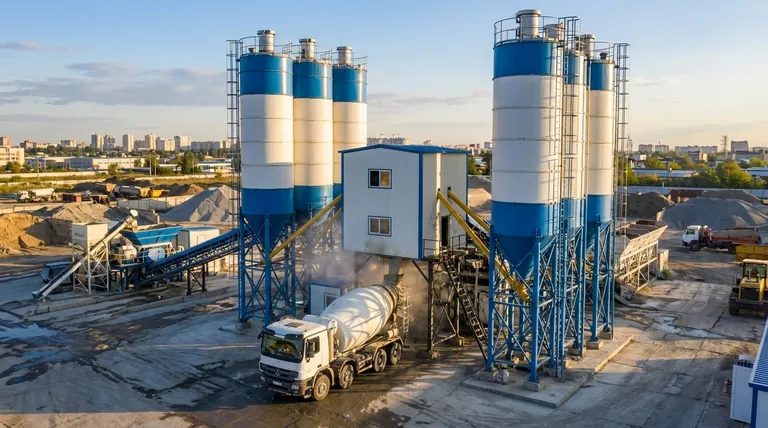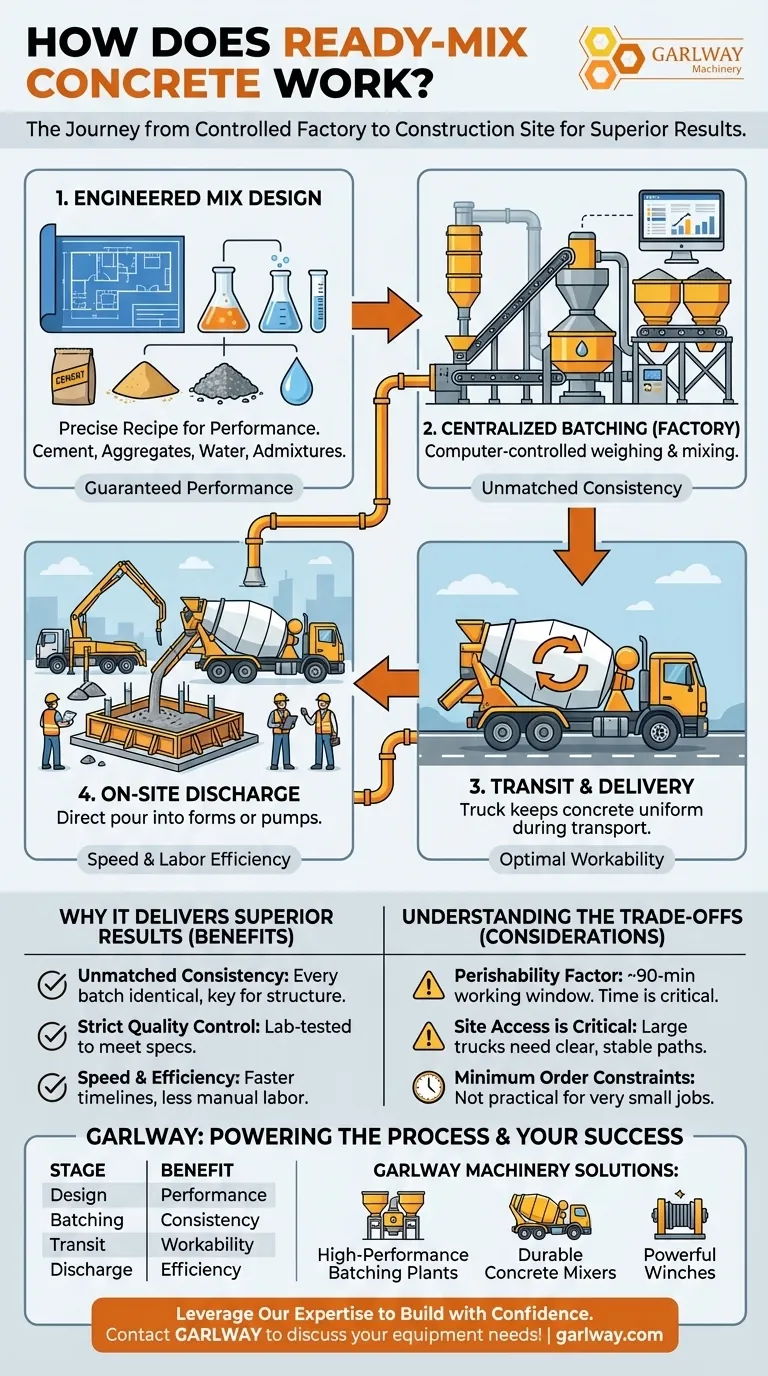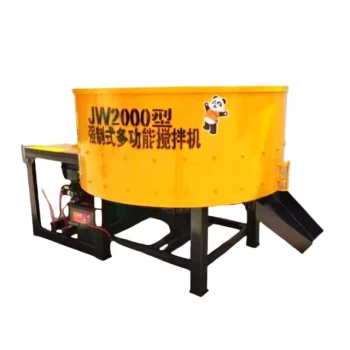In simple terms, ready-mix concrete is a highly controlled manufacturing process that happens off-site. Instead of mixing materials on the job, a specialized factory called a batching plant produces concrete according to a precise recipe, or mix design, and then delivers it directly to your project in a transit mixer truck.
The core principle of ready-mix is simple: it moves the complex science of creating high-quality concrete from the variable, uncontrolled environment of a construction site to the precise, controlled environment of a factory. This shift is what guarantees consistency and performance.

The Journey from Plant to Pour
The "ready-mix" process is a logistical chain designed to deliver a perishable product in its optimal state. Each step is critical to the final quality of the concrete.
The Engineered Mix Design
It all begins with a recipe. An engineer specifies the required performance—strength, durability, workability—and a technical team designs a mix with exact proportions of cement, sand, gravel (aggregates), and water. Chemical admixtures are often included to achieve specific properties.
Centralized Batching
At the heart of the operation is the batching plant. This facility stores all raw materials and uses computerized systems to weigh and dispense each component into a central mixer with extreme accuracy. This automated precision is impossible to replicate with on-site manual mixing.
Transit and Delivery
Once mixed, the concrete is discharged into a familiar transit mixer truck. The truck's rotating drum serves a dual purpose: it keeps the concrete's ingredients from segregating and continues the mixing process, ensuring the batch remains uniform and workable upon arrival.
On-Site Discharge
At the construction site, the truck operator works with your crew to discharge the concrete where it's needed, whether directly into forms, a pump, or wheelbarrows. The delivery is timed to match the pace of your placement and finishing team.
Why This Process Delivers Superior Results
Understanding the process reveals why ready-mix has become the industry standard for most professional applications. The benefits are a direct result of moving production off-site.
Unmatched Consistency
Because every batch is produced using the same computer-controlled equipment and verified mix design, the concrete you pour on Friday is identical to the concrete you poured on Monday. This consistency is fundamental for structural integrity.
Strict Quality Control
A batching plant operates like a lab. Technicians can test raw materials and the final product to ensure it meets specifications. This level of quality control provides a verifiable guarantee of performance that is simply not feasible on a job site.
Speed and Labor Efficiency
A single truck can deliver many cubic meters of concrete in minutes, far more than a crew could mix by hand in the same amount of time. This dramatically accelerates project timelines and reduces the on-site labor required for material handling.
Understanding the Trade-offs
While powerful, the ready-mix process introduces logistical dependencies that must be managed carefully.
The Perishability Factor
Once water is added to the cement, the clock starts ticking. The concrete has a limited workable life, typically around 90 minutes. Delays caused by traffic, site access issues, or an unprepared crew can result in a rejected load.
Site Access is Critical
Ready-mix trucks are large, heavy vehicles. Your site must have a clear, stable path for the truck to get to the pour location. Poor access can cause significant delays or make delivery impossible.
Minimum Order Constraints
Due to the operational costs, most suppliers have a minimum order quantity. For very small jobs, like setting a single fence post, the cost and logistics of a ready-mix delivery may not be practical compared to mixing a few bags on-site.
Making the Right Choice for Your Goal
Selecting between ready-mix and site-mix is a decision based on the demands of your project.
- If your primary focus is structural integrity and guaranteed performance: Ready-mix is the only choice. Its quality control and consistency are non-negotiable for foundations, slabs, and structural columns.
- If your primary focus is project speed and labor efficiency: Ready-mix is the superior option for any pour larger than a few cubic meters, allowing you to place vast quantities quickly.
- If your primary focus is a very small, non-critical task: On-site bag mixing offers greater flexibility and can be more cost-effective when the required volume is minimal.
By understanding this process, you can leverage ready-mix not just as a material, but as a strategic tool for ensuring quality and efficiency on your project.
Summary Table:
| Key Stage | Description | Key Benefit |
|---|---|---|
| Engineered Mix Design | A precise recipe is created for strength and durability. | Guaranteed Performance |
| Centralized Batching | Computer-controlled plant weighs and mixes materials. | Unmatched Consistency |
| Transit & Delivery | Truck keeps concrete mixed and uniform during transport. | Optimal Workability |
| On-Site Discharge | Concrete is poured directly where needed. | Labor Efficiency |
Ready to ensure superior quality and efficiency on your next project?
GARLWAY specializes in providing the robust construction machinery that makes the ready-mix process possible. Our concrete batching plants are engineered for precision and reliability, ensuring every batch meets the highest standards.
For construction companies and contractors globally, we offer:
- High-Performance Batching Plants: For consistent, quality-controlled concrete production.
- Durable Concrete Mixers: For reliable transit and mixing.
- Powerful Winches: For heavy-lifting support on site.
Leverage our expertise to build with confidence. Contact GARLWAY today to discuss your equipment needs and drive your project's success!
Visual Guide

Related Products
- HZS75 Concrete Batching Plant Cement Mixer Price Concrete Mixer Bunnings Mixing Plant
- HZS120 Ready Mix Concrete Batching Plant Commercial Mud Cement Mixer
- HZS180 Ready Mix Concrete Plant for Foundations with Sand and Cement
- HZS35 Small Cement Concrete Mixing Batch Plant
- Ready Mixer Machine for Construction Ready Mix Machinery
People Also Ask
- Can you mix self leveling concrete in a cement mixer? Avoid Costly Flooring Mistakes
- How much does a batching plant cost? Uncover the True Investment for Your Project
- Can you mix mortar in a cement mixer? Avoid weak joints and project failure.
- What are the disadvantages of ready mixed concrete? Navigate Logistical & Cost Risks
- How much weight can a cement mixer hold? A Guide to Choosing the Right Size for Your Project



















